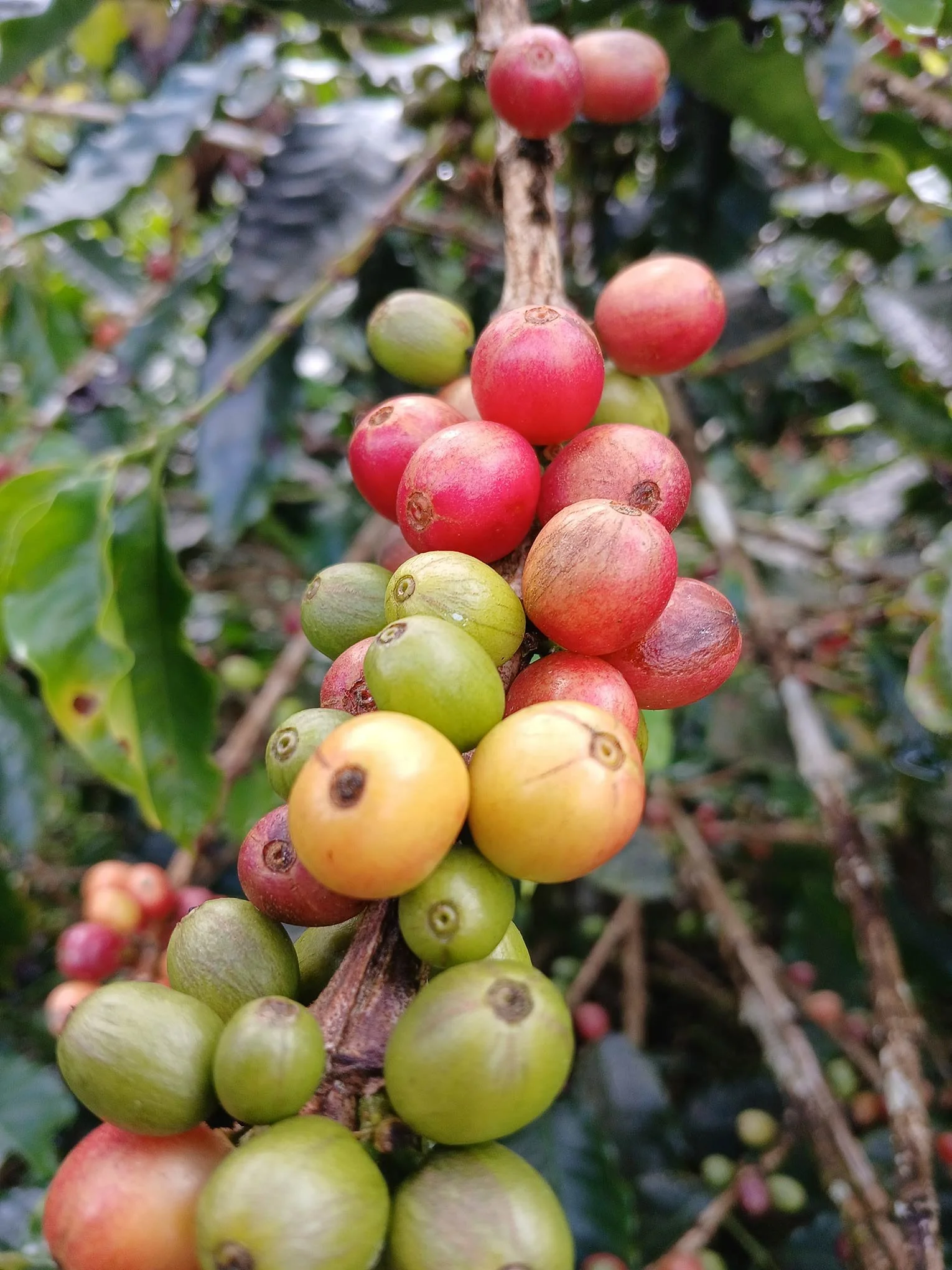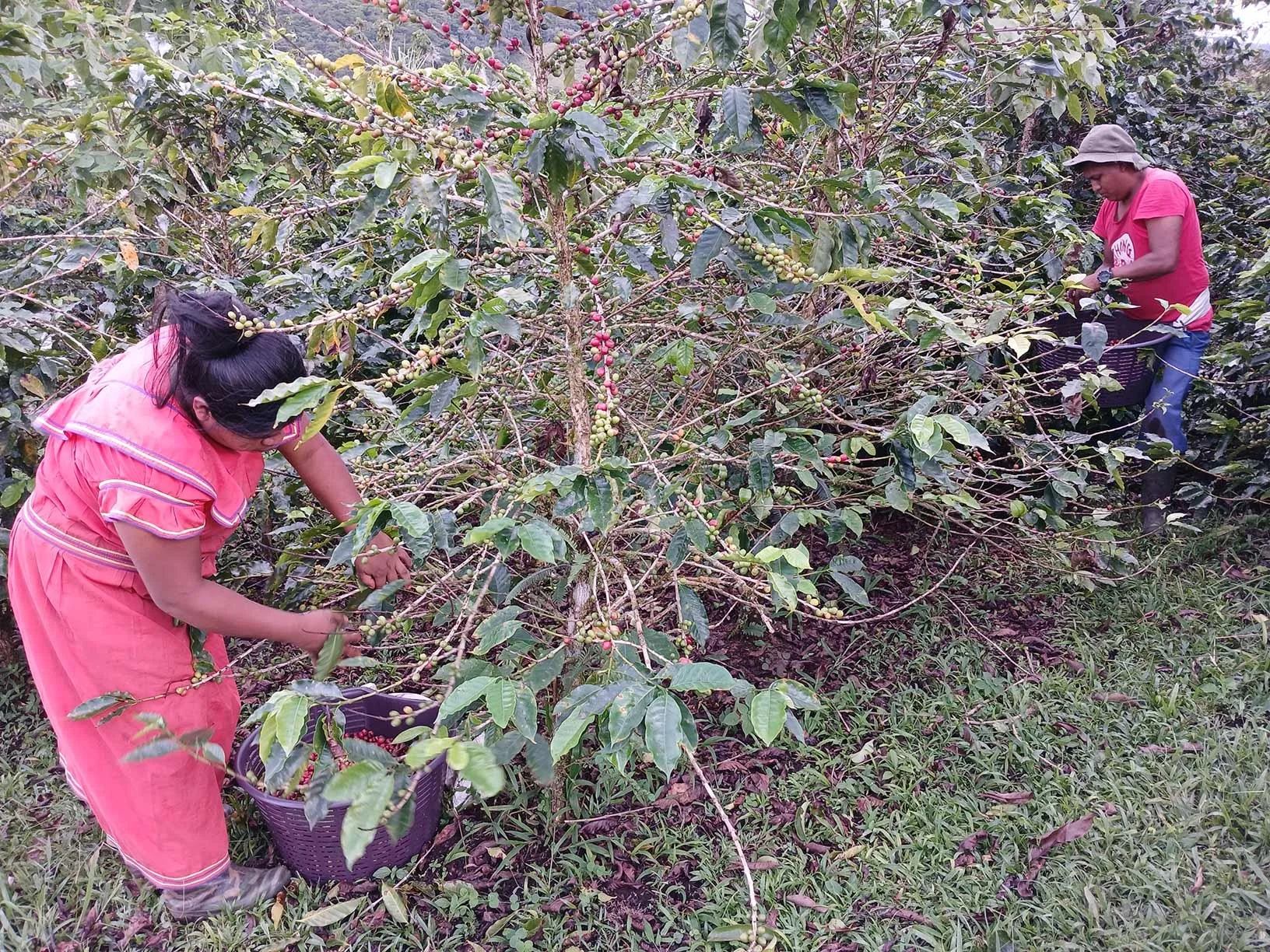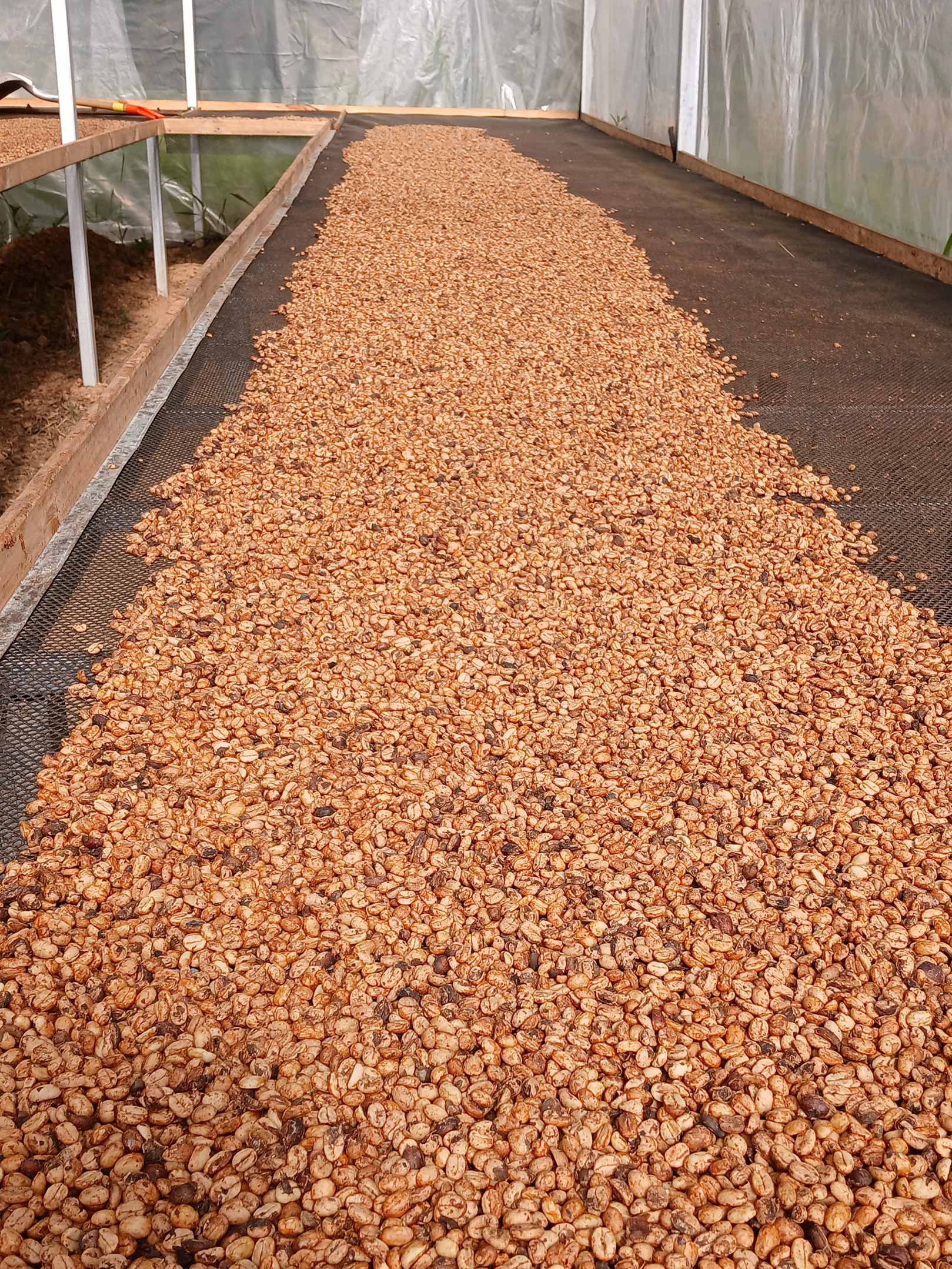How we Grow and Process our Coffee
Written by Colin, February 2025
When choosing a property, one of the elements we wanted was perennial plants that were already producing, so we wouldn’t have to wait for them to mature. On the property we bought, the biggest crop was coffee. Since 2022 we have planted out a variety of fruits, herbs, vegetables and staple crops, but coffee is still the biggest producer.
Our Field
Our variety is called Obata. It is a type of Arabica, which is the only category of coffee allowed in Costa Rica - the government outlawed Robusto many years ago. Our field was planted by the previous owner in 2014, when he bought the property. The plants are in full production now, but some are stunted because of having their trunks damaged by weed whacking or from lack of nutrients. A major plus was that the previous owner didn’t treat the plants with synthetic fertilizers or herbicides - this was amazing, given how rare that mentality is here and that he is otherwise a pretty regular local guy. So we started with a clean field. It consists of about 1500 plants across an acre of rows, about 260 of which we bought as seedlings to replace dying plants.
Seasons
The seasonality of our coffee is this: lots of little white flowers come around February, and attract lots of flying bugs; little green fruits grow over many months; the first ones ripen around August; the biggest harvests are in October and November; and it finishes around New Year’s. From August to December we do a round of harvesting every two weeks. That means a continual cycle for a number of months of drying and storing beans. After that, we can have them roasted at any time. We’ve been told the shelf life is up to a year when dried, and up to another year after roasting, though consuming soon after roasting is ideal.
Roles
Who does what in all this process? Colin oversees logistics, but knew nothing about growing coffee upon arrival here, so it’s been a learning curve. Tiffany handles the sales and shipping of our finished products. Our two part-time land workers do the fertilizing of the plants and keeping an eye on them year-round, including pruning for size and health once per year. They are locals who have tons of experience with coffee (which used to be the main economic driver here), and we lean on them heavily. Because we are unofficially organic, most of the products that Costa Ricans use on their coffee fields aren’t on the table for us. We’ve found some manufactured organic fertilizers, but mostly put a lot of dried chicken poop and active microorganisms on our field, as well as lime. It’s difficult to keep up with fertility needs. We’ve planted short poro trees to drop their leaves for nutrients as well as provide more shade, because our field didn’t have much shade when we arrived. It also includes banana trees, plantains, papayas, soursops, and mangosteens.
As far as pickers, in 2024 we used local indigenous people for the first time - before that we employed neighbor ladies to do it. Indigenous folks in our border area are the dominant coffee pickers, and some even migrate from Panama to the Central Valley around San Jose for the annual harvest. In the north there are lots of Nicaraguans doing this hard work. They are out there for hours - rain or shine - sometimes sunup to sundown. They bring enough people so it can all get harvested in one day. Ideally only red beans are picked, but some others fall off when brushed. Green, unripe beans add a bad flavor. Semi-ripe yellowish beans are in between, but best left for the next harvest. It has been an ongoing effort to harvest only the best beans, including in the face of economic incentive for pickers to harvest as much of all colors as possible, because they get paid by volume (not time).
Steps in the Process
The beans are picked, quality checked to remove any remaining green ones, measured, and the workers paid (the unit is a cajuela, which is about a cubic foot). We then float the fruits to separate good from bad. Each berry has two beans in it, and if at least one of them is damaged, then it floats. Everything that sinks is considered good, and then is sent through our electric depulper machine (chancador). Then we lay it out on mesh beds in a hoop house to dry. Last year we built our own drying station, which cost about $3,000 and 2 weeks of labor for our three construction employees. Now we can dry a lot of coffee (or anything else) at once. In its sunny location, and with little internal airflow, it’s so effective I call it the Horno (oven). For our first two years we took our product up the road to a family of three brothers who have a chancador and drying beds; now we carry out much of the processing steps onsite.
This method of processing is called honey (or miel) because some of the fruit stays on the beans as they dry, absorbing to add sweetness and flavor to the coffee. Most of what we do is honey processed, but at the very beginning and end of the picking season we do a small amount of natural, which is when we don’t use the depulper machine and instead let the whole fruits just dry straight on the beds. Since they are fully intact - and therefore large - the berries take a long time to dry, and if the weather is rainy they are more susceptible to get mold before getting fully dry. We also have a small amount of washed (lavado) coffee, which is from the fruits that floated. We send them through the chancador and then float them again. Whatever grains float then are composted, but the ones that sink are considered fine. In the process, much of the fruit goo on the outside of the beans gets washed off, so they are cleaner and lighter colored and dry faster, and have the name “washed.”
Drying
The drying time depends on how hot and sunny the drying location is, which of the three processes it is, and the weather. It can take as little as a few days to as long as a month, but the quicker the better to avoid mold, which is a danger lurking behind every cloud and dripping leaf in Costa Rica. A little bit of mold on the outside of the grains is OK, because that layer will be removed anyway, but once they turn all green on the outside (or another color) it’s lost. There are some varieties that ripen a few months later, in the summer, which must make drying a real breeze.
We test the coffee to see its dryness by using a moisture meter, a little device we brought from the U.S. It needs to get down to 11% to store it safely. The percentage goes up many points during the cool, wet nighttime, so the best time to remove it for long-term storage is late morning, after hours of blasting sun and before the afternoon rains come. Locals just bite a bean to assess its dryness level and know when it’s done.
Once dry, the beans (or grains - whichever word you like) are shelf stable for a very long time. We keep them in big white sacks in the loft of our pantry, where we have a dehumidifier going 24/7/365. They still have a layer of parchment paper covering on them - this is removed using a different machine before roasting.
Roasting
As to roasting, there are many ways to do that, from a cup’s worth at a time on the stovetop to massive industrial roasting apparatuses that burn forests of wood. There are tons of settings that are possible, and coffeeheads can really geek out on this stuff. We use a women’s co-op over an hour from our house for roasting, because they don’t have a minimum volume (most places here require at least 30 kg per roast type), do a great job, help their community and employees in various ways, have big vibration machines that separate out beans by size and density, and do hours of hand selection before roasting to ensure only good beans make it through. This is exhaustive and valuable. The separation puts the beans into 1st class, 2nd class, 3rd class, madre (the really big ones), and rejects. They then get roasted by size group - otherwise a small bean could get burned in the time it takes to bring a large one to a perfect roast. There is a neighborhood market for reject coffee (from this step or the initial floating or otherwise) so it’s worth it to have them roast it all, and then we can give away or sell cheaply the lower quality coffee for locals. We don’t have the ladies co-op grind the beans, so we can sell it whole bean.
Once roasted, the coffee sits in lined sacks in our pantry until we bring it to the U.S. to sell it, or make use of it at home. Our first season we generated something like 170 pounds of finished, roasted coffee. The second year it skyrocketed to around 650 pounds, and the third year looks like it will come at around 500 pounds. The wide variation seems to be because the previous owner didn’t weed or fertilize the field much, so basic care took the production way up, but the plants don’t have enough nutrients to sustain that level of production.
We roast some of our coffee medium and some dark. Light is a bold move, as it is mostly for connoisseurs. Dark roast is what much of the Global North is used to, because it hides imperfections in the flavor. We’ve been told this is how massive producers (think Starbucks and Dunkin’) like it, so consumers don’t know the real flavor, and can be fed cheap quality without realizing it. Medium roast shows the product itself more clearly. It’s astounding what a coffee expert can detect during a tasting session (which for a full version with one cup lasts an hour) - up to a few hundred different flavors. This includes detecting issues with the processing (Ex. it took too long to dry), citrus fruits versus yellow fruits, and dark chocolate versus lighter chocolate hues. Coffee can be a rabbit hole with no end. :)
Local Growing Culture
Our way of distributing coffee is unusual here, because we have access to a lucrative market - individuals in the U.S. So we can charge organic coffee prices per pound (or per cup, if we vend at an event) from a rich market. Most ticos don’t have this, or much infrastructure to process and dry coffee. So they sell to a beneficio, an industrial middleman that mostly exports to the rest of the world. Freshly harvested berries are taken there immediately, measured, and sold. This is convenient for the grower, but the downside is that they receive very little for it, barely enough to pay their pickers a basic rate and cover other costs of the year. Agronomists often come to their property as well, to tell them which chemicals to put on it, which are bad for the environment, so the industrial method here is not great. This reflects agriculture in Costa Rica in general, which is globalized and shortsighted in the sense that it relies on lots of dangerous chemicals. The biggest culprit is glyphosate (i.e. Roundup), an herbicide that kills grass and weeds really well, but also kills everything else. Depending on the source, Costa Rica is considered #1 or #2 in the world in glyphosate use, which is ridiculous for a country that totes itself as green and does lots of nature preservation. The population here is getting fatter and sicker, and this is one reason why. In fact, there appears to currently be no laboratory in the whole country that tests water for glyphosate, even though they spray it everywhere and it’s very dangerous. We want to test our well that is downhill from a spraying neighbor - but can only find tests for lots of other things in water, not big bad glyphosate.
Challenges and Maintenance
A major topic with coffee here is hindrances like illnesses or bugs. We have luckily had very little disease in our crop. Our major creature challenge is a tiny insect called broca. The name means drill (like a screwdriver attachment for making holes in wood) because the bug drills into the end of the coffee fruit and into a bean to eat it. It can damage or completely consume a grain, or even both grains. It has been a struggle to control it. We currently do lots of things for this: try to collect all coffee off the ground at each round of harvest, so the broca doesn’t have a long-term home; pick off the first infected grains of the season and solarize them to kill the bugs; put out traps for them; fertilize the bushes and try to strengthen them in general; and do a final clean in December that attempts to remove all grains from the coffee field between seasons.
A lesser challenge we have in our coffee field is matapalo, an invasive plant that is spread by birds. It grows right on the branches of a plant and sucks its energy. We pick them off manually when we see them, and cut out or spread salt around the base of nearby vegetation that has much matapalo in it.
Year-round we have to weed whack our coffee field about once per month to keep the grass short - otherwise locals tell me it weakens the coffee plants, and also doesn’t let the sun heat the ground like the plants like. We have to hand weed around the base of young plants as well, until they get big and shady enough that neither step is needed much.
Elevation is an important factor in coffee. At 2700 feet above sea level, we are toward the bottom of the elevation range where coffee grows. Ideal production and quality is higher, at perhaps 5000 feet. But it’s chilly up there, and we like the perfect temps where we are. :)
Coffee Culture
Speaking of our area, it used to be massively into coffee, with endless rolling fields and lots of workers. This has largely died out. The culture of this former/current coffee town is also not very well developed, compared to the other side of Baru volcano, where the town of Boquete, Panama has thriving tourism based partly on their primo coffee. In that town, it feels like production and consumption have come together, but in Coto Brus (our area) it’s just basic production, and what locals drink is cheap stuff, either NesCafe or Britt (the national brand they push at the airport). Coffee culture here consists mostly of rubber boots and machetes - locals working the fields. That work has transitioned over the decades from raw forest to coffee to cattle (the current #1), and sometimes back again to forest.
Each year we have taken our coffee to Boquete to visit an expert roaster and taster named Arturo. He gives us an unofficial rating and our flavor notes. We are around 85 on a scale of 100, which qualifies us as specialty coffee. Hearing that ours is organic, though, raises eyebrows and praise, because it is very difficult to grow great coffee without synthetic fertilizers and other products. Our coffee is considered to be sweet, a little fruity and chocolatey, and really good. Come try some. ;)






